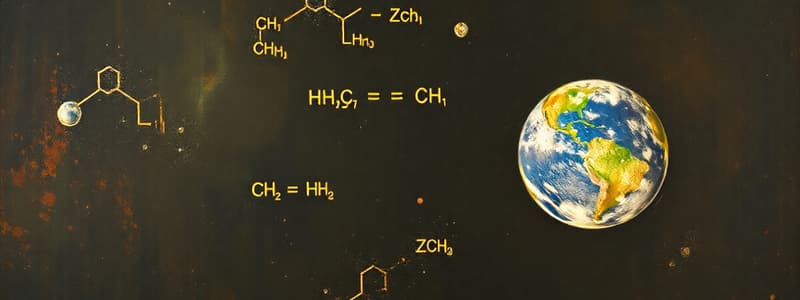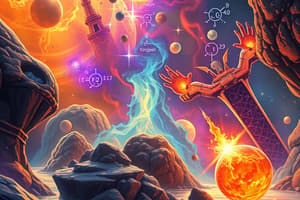Podcast
Questions and Answers
Which of the following correctly represents the law of conservation of mass?
Which of the following correctly represents the law of conservation of mass?
- Mass is only conserved in open systems
- Mass can be created during a chemical reaction
- Mass of products is greater than the mass of reactants
- Mass of reactants equals mass of products (correct)
Changing the subscripts of a chemical formula during balancing is acceptable.
Changing the subscripts of a chemical formula during balancing is acceptable.
False (B)
What is meant by the term 'reactants' in a chemical equation?
What is meant by the term 'reactants' in a chemical equation?
Reactants are the substances that undergo a chemical change to form products.
The gas __________ forms from the reaction of hydrogen and oxygen.
The gas __________ forms from the reaction of hydrogen and oxygen.
Match the following symbols with their meanings:
Match the following symbols with their meanings:
Flashcards
Chemical Equation
Chemical Equation
A symbolic representation of a chemical reaction using symbols and chemical formulas.
Balancing Chemical Equations
Balancing Chemical Equations
Ensuring the same number of each type of atom is on both sides of a chemical equation.
Coefficients
Coefficients
Numbers in front of chemical formulas in a balanced equation; they represent the number of moles.
Diatomic Molecules
Diatomic Molecules
Signup and view all the flashcards
Lavoisier’s Law of Conservation of Mass
Lavoisier’s Law of Conservation of Mass
Signup and view all the flashcards
Study Notes
Chemical Equations
- A chemical equation represents a chemical reaction using symbols and formulas.
- It has two main parts:
- Reactants (on the left side)
- Products (on the right side)
Diatomic Molecules (Gases)
- H₂: Hydrogen gas
- F₂: Fluorine gas
- Cl₂: Chlorine gas
- Br₂: Bromine gas
- I₂: Iodine gas
- O₂: Oxygen gas
- N₂: Nitrogen gas
Symbols Used in Chemical Equations
- (s): Solid
- (l): Liquid
- (g): Gas
- (aq): Aqueous (dissolved in water)
- ↑: Gas forms
- ↓: Solid precipitate (insoluble solid) forms
- →: "To yield/produce"
- ⇌: Reversible reaction (products can reform into reactants)
Applying Heat or Other Conditions
- Heat or other reaction conditions like temperature and pressure are sometimes noted.
Balancing Chemical Equations: Why?
- Lavoisier's Law of Conservation of Mass: In a closed system, matter is neither created nor destroyed during a chemical reaction. Mass remains constant. Therefore, the mass of reactants equals the mass of products.
Balancing Chemical Equations: How?
- Coefficients, not subscripts: Only change coefficients in front of the chemical formulas. Do not change the subscripts, as that would represent a different chemical.
- Coefficients represent moles: A coefficient indicates the number of moles of that substance in the reaction.
- Read the coefficients as moles 2Na is read as "2 moles of sodium".
- Reading chemical equations: "A + B → C + D" means "1 mole of A reacts with 1 mole of B to yield/produce 1 mole of C and 1 mole of D."
- Balancing Steps:
- Count the atoms of each element on both sides of the equation.
- Adjust coefficients to make the number of each type of atom equal on both sides (trial and error).
Studying That Suits You
Use AI to generate personalized quizzes and flashcards to suit your learning preferences.




